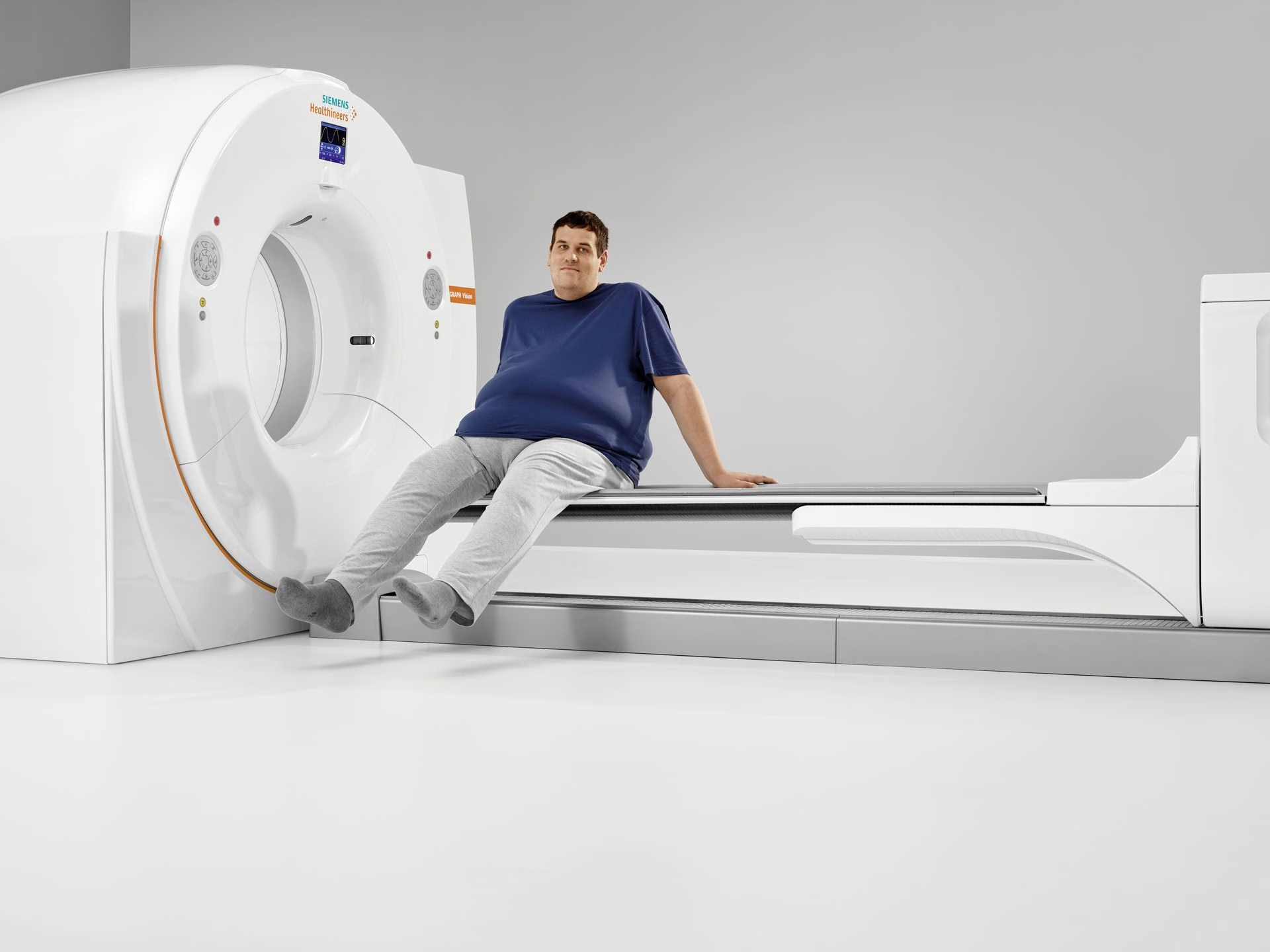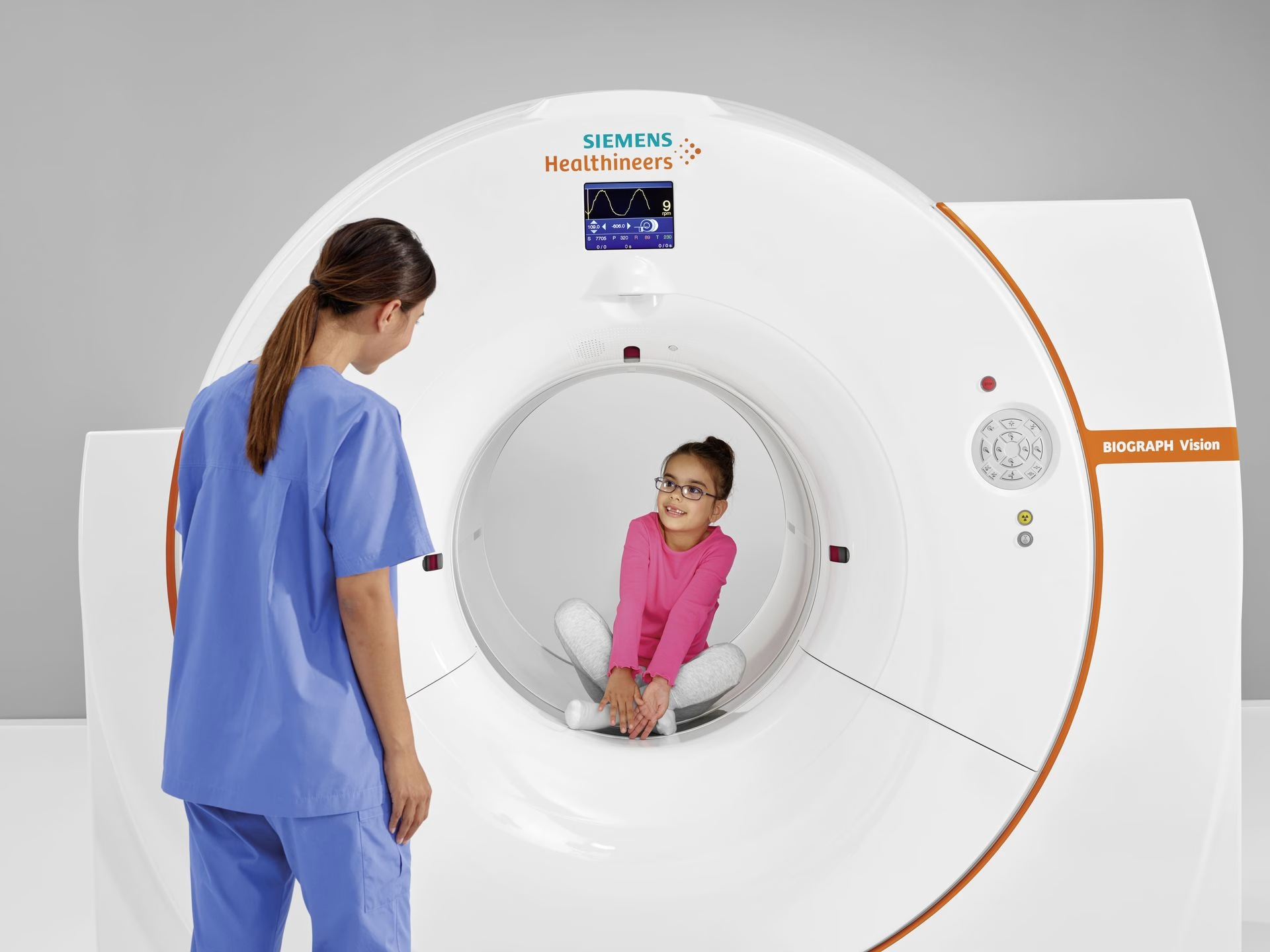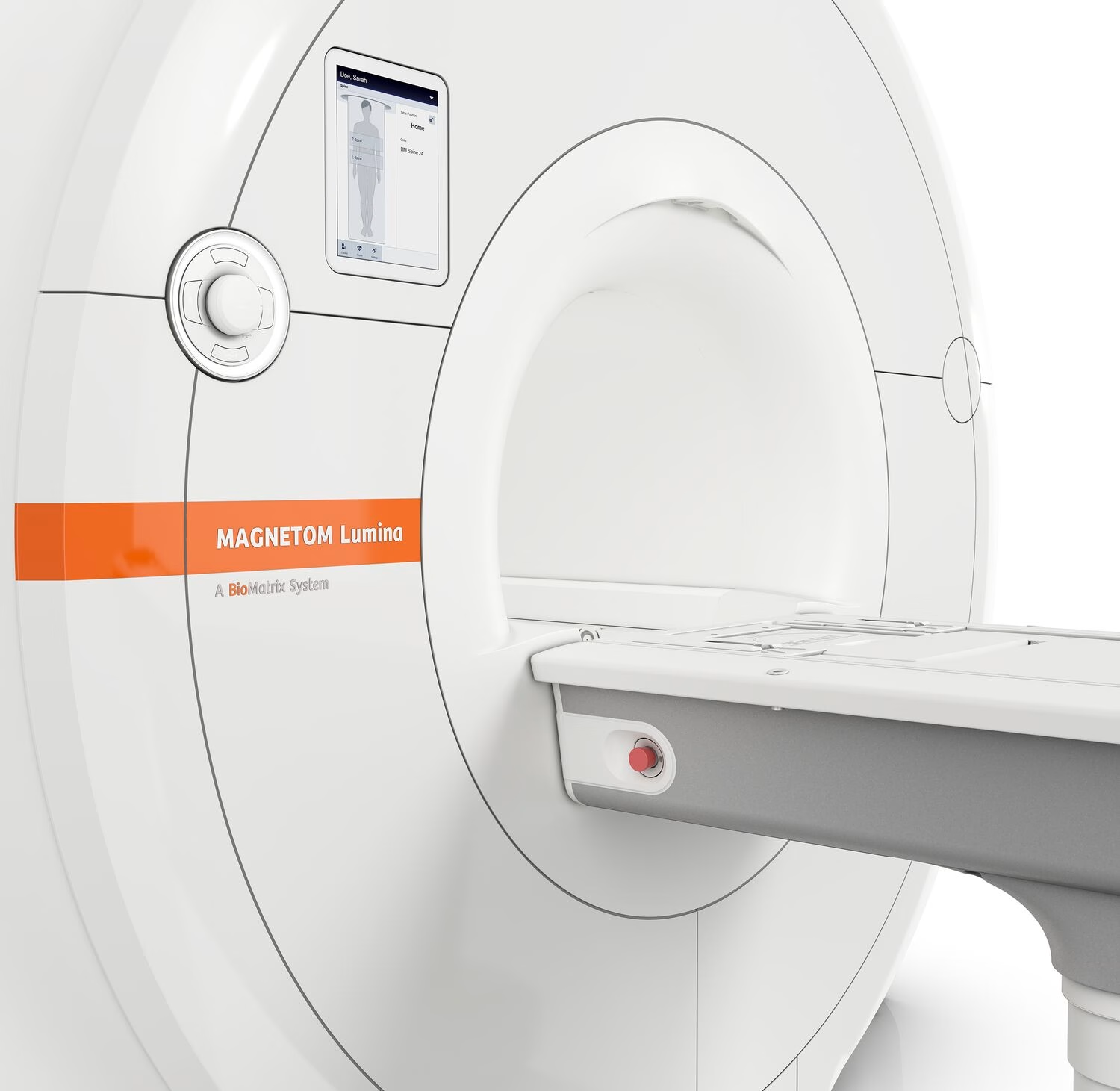Dijital PET/CT (FDG) Nedir?
Dijital PET/CT (FDG), Pozitron Emisyon Tomografisi (PET) ile Bilgisayarlı Tomografi’yi (CT) birleştiren ileri bir tıbbi görüntüleme işlemidir. Vücut içindeki metabolik aktiviteyi görselleştirmeye yardımcı olan radyoaktif bir şeker molekülü olan Florodeoksiglukoz (FDG) kullanır. Bu birleşik görüntüleme tekniği, dokuların ve organların hem yapısı hem de işlevi hakkında ayrıntılı bilgi sağlar, bu da çeşitli tıbbi durumların teşhis, tedavi ve takibinde yardımcı olur.
PET/CT (FDG) Görüntüleme Nasıl Yapılır?
- FDG Enjeksiyonu: Hastanın kan dolaşımına az miktarda FDG enjekte edilir.
- Hücre Emilimi: FDG, kanser hücreleri gibi yüksek metabolik aktiviteye sahip alanlarda birikir çünkü bu hücreler normal hücrelerden daha yüksek oranda şeker tüketir.
- PET Tarama: PET tarayıcı, FDG tarafından yayılan radyasyonu tespit eder ve FDG’nin vücutta biriktiği yerleri gösteren görüntüler oluşturur.
- CT Tarama: CT tarayıcı, vücudun iç yapılarının ayrıntılı X-ışını görüntülerini alır.
- Birleştirilmiş (Füzyon) Görüntüler: PET ve CT görüntüleri birleştirilerek herhangi bir anormalliğin (patolojinin) yerini ve metabolik aktivitesini gösteren net görüntü sağlanır.

PET/CT (FDG) Kullanım Alanları:
- Kanser Tespiti ve Yönetimi:
– Kanser Türleri: Hemen hemen tüm kanser türlerinde kullanılıyor olmakla beraberö başlıca akciğer kanseri, meme kanseri, mide kanseri, kolorektal kanser, pankreas kanseri, lenfoma, melanom, baş ve boyun kanseri, özofagus kanseri, rahim ağzı kanseri, pankreas kanseri ve tiroid kanseri.
– Tespit: Kanser hücrelerini erken tespit eder.
– Evreleme: Hastalığın yayılma durumunu göstererek kanser evrelemesini tespit eder.
– Tedavi İzleme: Anatomik boyut ve metabolik aktivitedeki değişiklikleri tespit ederek tedavinin etkinliğini izler.
– Nüks Tespiti: Yüksek metabolik aktiviteye sahip yeni alanları tespit ederek kanserin nüksünü erken dönemde tespit eder.
- Kalp Hastalıkları:
– Değerlendirme: Kalp kaslarına kan akışını değerlendirir.
– Tespit: Koroner arter hastalığını gösterebilecek azalmış kan akışı alanlarını tespit eder.
– Planlama: Anjiyoplasti veya bypass ameliyatı gibi prosedürleri planlamaya yardımcı olur.
- Beyin Anormallikleri:
– Tespit: Beyin fonksiyonlarındaki anormallikleri tespit eder.
– Teşhis: Alzheimer hastalığı, epilepsi ve beyin tümörleri gibi durumların teşhisinde yardımcı olur.
– Değerlendirme: Beyin yaralanmalarını ve bunların kapsamını değerlendirmeye yardımcı olur.
Dijital PET/CT ve Analog PET/CT Arasındaki Fark:
- Görüntü Kalitesi:
– Dijital PET/CT: Daha iyi netlik ve ayrıntıya sahip yüksek çözünürlüklü görüntüler sağlar. Bu, anormalliklerin daha erken ve daha doğru tespit edilmesini ve yerinin net olarak belirlenmesini sağlar.
– Analog PET/CT: Daha düşük çözünürlüklü ve daha az ayrıntılı görüntüler sunar, bu da bazen küçük veya erken evre anormalliklerin kaçırılmasına neden olabilir.
- Hız ve Verimlilik:
– Dijital PET/CT: Görüntüleme hızı daha fazla olduğu için daha kısa sürede tamamlanır, bu da hastalar için daha rahat bir deneyim sağlar.
– Analog PET/CT: Görüntüleme hızı daha düşük olduğu için daha uzun sürede tamamlanır, bu da hastalar için daha az konforlu olabilir.
- Radyasyon Dozu:
– Dijital PET/CT: Yüksek kaliteli görüntüler sağlarken daha düşük radyasyon dozuna ihtiyaç duyar, bu da hastalar için daha güvenlidir.
– Analog PET/CT: Benzer görüntü kalitesi elde etmeye çalışmakiçin daha yüksek radyasyon dozu gerektirir, bu da hasta güvenliği için bir sorun olabilir.
- Teşhis Doğruluğu:
– Dijital PET/CT: Anormallikleri tespit etmede daha yüksek sensitivite (duyarlılık) ve spesifite (özgüllük) sağlar, bu da daha net ve doğru teşhiskonmasını sağlar.
– Analog PET/CT: Daha düşük sensitivite (duyarlılık) ve spesifite (özgüllük) olması sebebiyle daha az doğru teşhise ve ek testlere ihtiyaç duyulmasına neden olabilir.
Dijital PET/CT’nin Avantajları:
– Üstün Görüntü Kalitesi: Daha net ve ayrıntılı görüntüler sağlayarak teşhis doğruluğunu artırır.
– Daha Hızlı Tarama: Hastaların görüntülemede geçirdiği süreyi azaltarak konfor ve verimliliği artırır.
– Daha Düşük Radyasyon Dozu: Radyasyon maruziyetini en aza indirerek hasta güvenliğini artırır.
– Daha İyi Tespit: Küçük veya erken evre anormallikleri daha doğru tespit ederek erken ve daha etkili tedavi sağlar.
PET/CT (FDG) Görüntüleme Randevunuz İçin Nasıl Hazırlanmalısınız?
- Aç Kalma: Randevunuzdan önce 4-6 saat boyunca su dışında hiçbir şey yemeyin veya içmeyin.
- Hidrasyon: Görüntüleme öncesinde bol su için.
- İlaçlar: Doktorunuz aksini belirtmedikçe olağan ilaçlarınızı alın.
- Egzersizden Kaçının: Görüntüleme öncesindeki 24 saat boyunca yorucu egzersiz yapmaktan kaçının.
- Giyim: Metal fermuar veya düğme içermeyen rahat ve bol kıyafetler giyin. Kadınlar, spor sütyeni gibi tel veya klips içermeyen bir sütyen giymeye çalışmalıdır.
- Doktorunuza Bildirin: Hamileyseniz, emziriyorsanız veya özellikle iyot veya kontrast maddelere alerjiniz varsa doktorunuza bildirin.
PET/CT (FDG) Görüntüleme Randevusundan Sonra:
- Hidrasyon: FDG’nin vücudunuzdan atılmasına yardımcı olmak için bol su içmeye devam edin.
- Normal Aktivitelere Devam: Doktorunuz aksini belirtmedikçe genellikle görüntülemeden hemen sonra normal aktivitelerinize devam edebilirsiniz.
- Sonuçlar: . Görüntüler incelenip sonuçlar bir gün içerisinde rapor edilecektir.
Dijital PET/CT (FDG), onkoloji, kardiyoloji ve nöroloji alanlarında çeşitli tıbbi durumların teşhis ve yönetimini önemli ölçüde geliştiren ileri bir teknoloji olup, geleneksel analog PET/CT’ye göre birçok avantaj sunar. Bu, modern tıbbi görüntülemede kritik bir araç olup, sağlık profesyonellerinin hasta bakımına yönelik bilinçli kararlar almasına yardımcı olan önemli bilgiler sağlar.


Şimdi randevu almaya hazır mısınız?